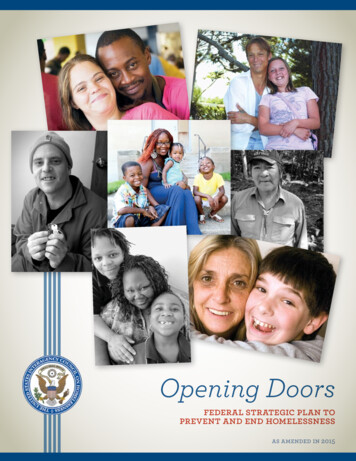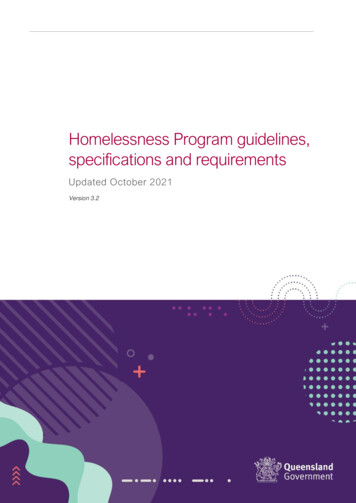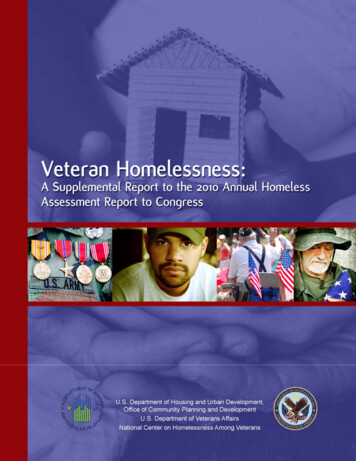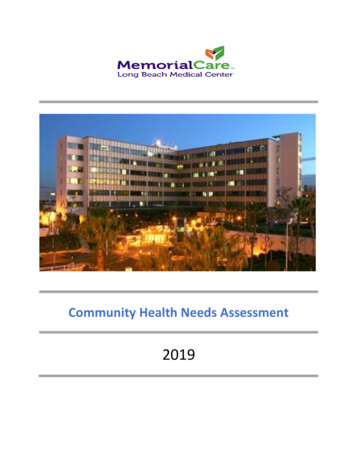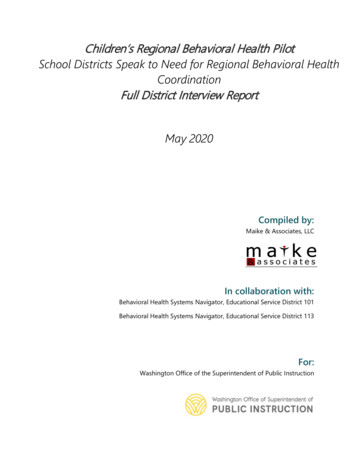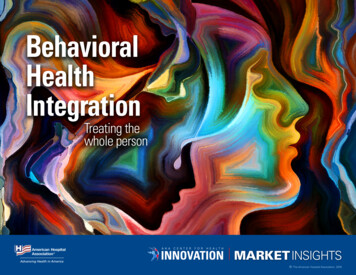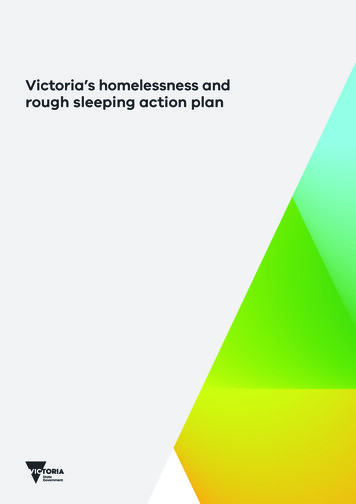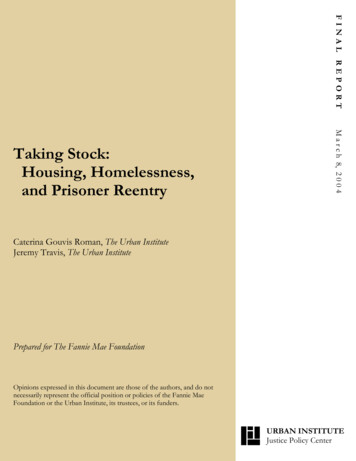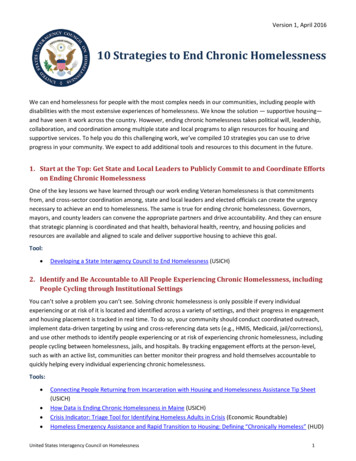
Transcription
DISTRICT 2DISTRICT 3DISTRICT 6DISTRICT 1DISTRICT 5DISTRICT 4DISTRICT 8DISTRICT 9DISTRICT 7DISTRICT 10DISTRICT 11Behavioral Health andHomelessness in San Francisco:Needs and OpportunitiesIn July 2017, Tipping Point Community launched an initiative to reduce chronichomelessness in San Francisco. As part of this initiative, Tipping Point Communityand the University of California, San Francisco (UCSF) Department of Psychiatrycame together to share expertise and strategize about how to raise philanthropic andprivate-sector funding to work alongside sustainable public investments to improveoutcomes for San Francisco residents experiencing long-term homelessness whoalso have behavioral health care needs (including mental health conditions and/orsubstance use disorders).SEPTEMBER 2019
San Francisco has been a national leader in innovation and implementation of best practices inthe fields of behavioral health and homelessness; yet, there is more work to be done. The populationof people experiencing homelessness in San Francisco, and across the Bay Area, is growing, and theBlack/African-American community is disproportionately impacted by homelessness. Despite continuedinvestment in combatting homelessness, 2019 Point-in-Time Count data indicate a 17% increase from 2017,with neighboring counties experiencing even larger increases (31% in Santa Clara, and 43% in Alameda).People are becoming newly homeless in San Francisco every day. This underscores the complexity ofthe problem, rooted in a national disinvestment in public housing and growing income inequality. Whilesolutions must incorporate Federal and State strategies, there is urgent need for collective action acrossSan Francisco to develop solutions, particularly for local residents with a behavioral health need.Substance use disorders (SUDs) and serious mental illnesses impact an individual’s daily life and canhave negative consequences for securing and maintaining housing and employment, criminal justiceinvolvement, maintaining social and family relationships, and the ability to carry out self-care activities.There are systemic barriers to accessing mental health and SUD treatment, as well as individual barriersincluding personal readiness, stigma, and lack of awareness of treatment options. When treatment isavailable and an individual is ready to receive care for their behavioral health needs, the optimal outcomeis often stabilization and recovery, not a permanent cure. Relapses and setbacks are a common partof the recovery process, and many individuals will engage with some form of treatment or services formuch of their lives. Effective treatment for SUD and serious mental illness supports progression towardstabilization and recovery, and allows individuals to live self-directed, purposeful lives.The San Francisco Department of Public Health (DPH) Behavioral Health Services (BHS) providesservices to more than 30,000 San Francisco residents each year, many of whom receive the care andtreatment they need to achieve stabilization and positive health outcomes. However, the most vulnerableand complex patients in the City—people experiencing homelessness who also have behavioral health(and often physical health) needs—are struggling. To better meet the needs of this population, systemimprovements need to be made to effectively engage the population in services and provide ongoingtreatment throughout the process of stabilization and recovery.John Snow, Inc. (JSI) was commissioned by Tipping Point Community and UCSF to conduct anassessment of the needs of the target population and develop a set of recommendations on how toimprove the existing care delivery system in San Francisco for these individuals. Specifically, the goalsof this project were to: Identify key gaps that exist in the current system as related to: services andtreatment; coordination across agencies and providers; data availability; andaccess and outcome disparities based on race, ethnicity, LGBTQ status, andother demographics that correlate with disproportionate homelessness; Identify existing and planned efforts to address these gaps; and Make recommendations for where philanthropic, private, and/or public investmentcould have an impact, including prioritization based on cost, impact, and urgency.INTRODUCTION BEHAVIORAL HEALTH AND HOMELESSNESS IN SAN FRANCISCO2
IN COLLABORATION WITH TIPPING POINT COMMUNITY AND UCSF, THE JSI TEAM DEVELOPEDA VISION STATEMENT TO GUIDE THIS PROJECT:San Francisco's system of care should know the names and needs of everyone who ishomeless with a behavioral health care need (regardless of how they come into thesystem and whether they are currently using it); provide wrap-around services thatpromote stabilization and a path to permanent housing; and ensure that systemsand services proactively address and reduce disparities impacting Black/African Americanand LGBTQ individuals experiencing homelessness.While the biggest barrier to stabilization is the lack of affordable housing, this report identifies severalkey areas of investment that would improve the systems serving some of San Francisco’s most vulnerableresidents: 1) enhanced coordination to more effectively transition people between levels of care;2) increased treatment and care capacity, with an emphasis on additional residential care facilities andtreatment for people suffering from chronic alcoholism and methamphetamine use; and 3) improvementsin outreach and engagement to facilitate access to care.THIS REPORT INCLUDES:1. an executive summary (PAGE 4)2. a description of the data collection methodology and analysis that was usedto inform the recommendations presented in this paper (PAGE 5)3. a brief background on the homelessness and behavioral health care systemsin San Francisco (PAGE 7)4. a summary of findings, including the current policy landscapeinfluencing these systems (PAGE 12)5. a set of recommendations (PAGE 19)INTRODUCTION BEHAVIORAL HEALTH AND HOMELESSNESS IN SAN FRANCISCO3
1. EXECUTIVE SUMMARYVISIONSan Francisco's system of care should KNOW the names and needs of everyonewho is homeless with a behavioral health care need (regardless of how they comeinto the system and whether they are currently using it); PROVIDE wrap-aroundservices that promote stabilization and a path to permanent housing; and ENSUREthat systems and services proactively address and reduce disparities impactingBlack/African American and LGBTQ individuals experiencing homelessness.GOAL 1GOAL 2GOAL 3IMPROVE SYSTEMCOORDINATIONENHANCE ACCESSTO TREATMENTINCREASEENGAGEMENT Improve access toshort- and long-termhousing for all levelsof care Improve data onclients and existingresources throughdevelopment ofshared dataplatforms Establish sharedclient-centeredoutcome goalsacross departments Add additionaltreatment beds acrossthe continuum of care,including resources formethamphetamine useand chronic alcoholism Improve system-widecoordination andaccountability Increase support forcare transitions andmaintenance Expand field-basedbehavioral healthservices Build trust throughthe creation ofadditional safespaces and harmreduction services Implementclient-centered,responsive servicesincluding linkageand transportationThrough collective will and urgent action, San Francisco’smost vulnerable residents will be supported in achievingHEALTH, HOUSING, and PURPOSE.EXECUTIVE SUMMARY BEHAVIORAL HEALTH AND HOMELESSNESS IN SAN FRANCISCO4
2. METHODOLOGYIn order to make recommendations on how to improve the existing safety-net caredelivery system for people in San Francisco who are experiencing homelessness andhave behavioral health needs, the JSI team carried out a systematic mixed-methodsprocess to collect data regarding gaps and needs for this population, analyze datato identify the key gaps, and identify and prioritize potential solutions.Data CollectionTo identify the gaps and make recommendations for systems improvement, the JSI team collecteddata from six different sources, described in detail below. Data collection was conducted betweenNovember 2018 and April 2019.1. MONTHLY MEETINGS WITH ADVISORY COMMITTEE: At the project's inception, JSI formed anAdvisory Committee, composed of 10 experts, agency leaders, and key stakeholders connectedto the homelessness and behavioral health systems of care in San Francisco. Advisory Committeemembers included representatives from DPH, HSH, UCSF, Hospital Council, Positive ResourceCenter, and HealthRight360 (see Appendix III for a list of Advisory Committee members). Thesemembers were selected based on their expertise in the field and their ability to lend contentknowledge and experience to the findings and ultimate set of recommendations. The JSI teamconvened the Advisory Committee four times from November 2018 to April 2019. These meetingsalso served as a data collection method to ascertain emerging needs and to provide updates onexisting initiatives for this population.2. REVIEW OF EXISTING DATA REPORTS: JSI conducted a review of existing data and availablereports covering relevant populations and systems in San Francisco. Reports and data sources wererecommended by Tipping Point Community, UCSF, key informants, members of the AdvisoryCommittee, and DPH leadership. The full list of reviewed documents can be found in Appendix I.3. KEY INFORMANT INTERVIEWS: In collaboration with Tipping Point Community and UCSF,the JSI team developed an initial list of key informants in the City and County of San Francisco.The JSI team expanded the list to include recommendations from DPH leadership, the AdvisoryCommittee, and key stakeholders. These interviewees included clinicians, service providers fromnon-profit organizations, and leadership from the entire system of care surrounding homelessnessand behavioral health, including DPH, the Department of Homelessness and Supportive Housing(HSH), and cross-agency teams. In total, the JSI team interviewed 34 key stakeholders using asemi-structured interview guide (see Appendix II for a list of interviewees). The JSI team tookextensive notes during the interviews for subsequent content analysis. Interview topics includedexisting services and the system of care; challenges and barriers at the patient, provider, and systemlevels; existing gaps in the system; needs of the target population; and opportunities for enhancingthe system of care.METHODOLOGY BEHAVIORAL HEALTH AND HOMELESSNESS IN SAN FRANCISCO5
4. SCAN OF NATIONAL BEST PRACTICES: JSI conducted a review of national literature andinnovative programs to assess best practices around the country for addressing the needs of peoplewho are experiencing homelessness and have behavioral health needs. The national best practicesscan allowed for examination of innovative and effective programs and practices in a variety ofcities, and identification of the evidence base for reducing homelessness and treating behavioralhealth conditions with this population.5. MONTHLY MEETINGS WITH DPH LEADERSHIP: The JSI team met with DPH leadershipin monthly meetings from December 2018 to April 2019, to provide updates on progress andfindings and receive input and guidance for the project.6. CLIENT FOCUS GROUP: JSI held a focus group at Hummingbird Place Psychiatric Respite with20 individuals with behavioral health needs who are experiencing or have recently experiencedhomelessness. These individuals were overnight clients at Hummingbird Place at the time ofthe focus group. Discussion topics included existing services accessed by clients; challenges andbarriers faced; existing gaps in the system; and opportunities for enhancing the system of care.Data AnalysisJSI team members reviewed all data, interview notes, and meeting notes. Common themes emerging fromthe stakeholder interviews and meetings were identified on an ongoing, iterative basis, and synthesizedwith information collected from the review of existing reports. Each month, emerging themes werepresented to DPH and the Advisory Committee for review, discussion, and refinement. DPH and theAdvisory Committee provided clarification on the emerging findings and offered recommendations forwhere to seek additional information both through new key informant interviews and through additionalliterature resources.METHODOLOGY BEHAVIORAL HEALTH AND HOMELESSNESS IN SAN FRANCISCO6
3. BACKGROUNDSan Francisco HomelessnessHomelessness is driven by poverty and a shortage of affordable housing. While most people are homelessfor a single, short episode, about a quarter of the population nationally remains unstably housed for longer.“Chronically homeless” individuals—defined as people who experience homelessness in repeat episodes—often also suffer from disabling conditions like mental health or substance use disorders, which preventthem from maintaining housing and employment.iAccording to the 2019 Point-in-Time Count, there were approximately 8,011 individuals experiencinghomelessness on any given night in San Francisco, approximately 3,028 (38%) of whom were chronicallyhomeless. This number continues to rise; according to the Department of Homelessness and SupportiveHousing, for every person who exits homelessness in San Francisco, three people become newly homeless.A growing number of people experiencing homelessness are over age 60 (10% of the homeless populationin 2019, compared to 3% in 2013), and more people are becoming homeless for the first time over age 50.Twenty-seven percent of San Francisco’s homeless population, and almost half of the San Franciscohomeless population under 25, identify as LGBTQ, and 37% are Black/African-American (see the textboxes that follow for additional information).Individuals experiencing chronic homelessness are disproportionately unsheltered, suffer from disablingconditions, and are high users of multiple systems (including the medical system, mental health system,and substance use system).ii According to the 2019 Point-in-Time Count (in which data is self-reported),the 3,028 chronically homeless individuals in San Francisco have higher rates of drug and alcohol misuse,psychiatric or emotional conditions, and substance use as the primary cause of their homelessnesscompared to the non-chronically homeless population (see Figure 1 below for detail).FIGURE 1:SELF-REPORTEDBEHAVIORAL HEALTHCONDITIONS IN HOMELESSAND CHRONICALLYHOMELESS POPULATIONSIN SAN FRANCISCO63%32%53%32%15%24%(2019 POINT-IN-TIME COUNT)NON-CHRONICALLY HOMELESSDRUG ANDALCOHOL USECHRONICALLY HOMELESSPSYCHIATRICOR EMOTIONALCONDITIONSDRUG OR ALCOHOLUSE AS PRIMARYCAUSE OFHOMELESSNESSi Chronic homelessness is defined by the Department of Housing and Urban Development as “someone who has experienced homelessness for ayear or longer, or who has experienced at least four episodes of homelessness in the last three years, and also has a condition that prevents them frommaintaining work or housing” (Point-in-Time, 2017).ii Individuals who are unsheltered are sleeping outdoors, on the street, in parks, or in vehicles. Sheltered individuals are experiencing homelessness butare residing in temporary shelter, including emergency shelters or treatment facilities.BACKGROUND BEHAVIORAL HEALTH AND HOMELESSNESS IN SAN FRANCISCO7
Data from San Francisco's Coordinated Care Management System (CCMS) database suggests thesefigures could be higher among the general homeless population; of the 10,856 individuals who experiencedhomelessness in 2016/2017 and accessed care at DPH, 58% had been treated for serious mental healthdisorders and 63% had a history of drug or alcohol misuse.The San Francisco Department of Homelessness and Supportive Housing (HSH) was establishedin August of 2016 under former Mayor Edwin Lee in an effort to create a single department to alignresources and strategy around homelessness and create a service system that connects them to housing.HSH oversees the shelter system, street outreach, and strategies to decrease homelessness, includingthe coordinated entry system into supportive housing.Racial Disparities in Homelessness and Behavioral HealthNationally, there is a striking racial disparity in the homeless population; the disparity inSan Francisco is even greater: Black/African American residents make up less than 6% ofthe total population, yet make up 37% of the homeless population and nearly half of those whohave been homeless for 10 or more years.This disparity is the result of structural racism and historic discrimination that have restrictedaccess to higher-earning jobs, community supports, and homeownership. Mass incarcerationof the Black population has meant that public housing and other supportive services have beenlegally less accessible to this community. Furthermore, lack of family wealth and limited accessto credit have increased foreclosure risk for Black families.People of color also experience high rates of mental health conditions, substance use, andtraumatic stress, and experience worse behavioral health outcomes than White populations.In San Francisco, the Black overdose death rate is three times higher than the rate for Whitepopulations. Black men die at almost twice the rate of White men from liver cirrhosis, thoughthey have lower rates of alcohol use disorder.Among the population of people experiencing homelessness in San Francisco who have abehavioral health condition, Black individuals are the sickest and most vulnerable. The evidencesuggests that physical health, behavioral health, and housing systems are not meeting the needsof people of color, and they should be considered an urgent priority for the system of care.BACKGROUND BEHAVIORAL HEALTH AND HOMELESSNESS IN SAN FRANCISCO8
Behavioral Health System of CareThe San Francisco Department of Public Health (DPH)Behavioral Health Services (BHS) provides services to morethan 30,000 San Francisco residents each year, at a budgetedcost of 370 million. The system of care includes DPH,multiple hospitals, and community-based organizations,and encompasses more than 300 different programs. Asshown in Figure 2, these services include mental health crisisservices, mental health hospitalization and inpatient services,long-term care in locked and unlocked facilities, residentialdetox services, residential treatment, outpatient treatment,prevention, as well as linkage and coordination betweenservices and levels of care. Additionally, there are 185 bedsin the county jail that are designated as psychiatric beds,including 96 general population beds with behavioral healthservices, 52 segregated beds, 13 observation beds, and24 psychiatric overflow beds.FIGURE 2:CUNANOPREVENTION AND EARLY INTERVENTIONTESAN FRANCISCO BEHAVIORAL HEALTH SERVICESOUTPATIENT TREATMENTCRISIS PROGRAMSLOCKEDFACILITIESBACKGROUND UTEHOSPITALIZATIONAND INVOLUNTARYTREATMENTACIndividuals maymove betweendifferent levelsof care dependingon their needRESIDENTIAL TREATMENTBEHAVIORAL HEALTH AND HOMELESSNESS IN SAN FRANCISCOHomelessness in theLGBTQ PopulationLGBTQ individuals are disproportionatelyrepresented in the population of peopleexperiencing homelessness in SanFrancisco. Data suggest that theseindividuals are more likely to beexperiencing homelessness for the firsttime and are less likely to have behavioralhealth conditions; however, beingLGBTQ and experiencing homelessnesscomes with unique challenges. Forexample, LBGTQ individuals mayfeel unsafe in traditional shelters thatseparate residents by the gender assignedto them at birth, and some may haveexperienced trauma related to rejectionfrom their families and communities.San Francisco has been a leader inproviding services targeting LGBTQindividuals experiencing homelessness.The City has the first shelter focusedon serving LGBTQ adults experiencinghomelessness (offering 24 beds), and oneof the only LGBTQ-specific supportivehousing programs for youth in thecountry (23 beds). Additionally, throughthe San Francisco LGBT CommunityCenter, DPH has provided 1.5 millionfor six years of mental health services foryouth experiencing homelessness.These programs are in high demand; theLGBTQ shelter and supportive housingalways have a waitlist, suggesting thatthere is a critical need for expandedservices designed for the LGBTQpopulation experiencing homelessness.9
Homelessness and Behavioral Health in San FranciscoSubstance use disorder and mental illness can be both causes and consequences of homelessness, resultingin a high prevalence of behavioral health conditions among chronically homeless populations.1,2,3 In 2016–17,13% of BHS mental health clients were homeless and an additional 12% did not have identified housing.4From 2016–2018, the leading cause of death among people experiencing homelessness was unintendedoverdose (35% of deaths), with an additional 5.6% resulting from chronic alcoholism and associatedconditions, and 4.9% from acute alcohol toxicity.5 People who are experiencing both homelessness andbehavioral health issues need services and coordination from numerous departments and through multiplelevels of care, including a place to sleep. The complex array of services needed and the associatedtransitions of care require a high level of coordination and cooperation, and services need to be availableto clients when they are ready to receive them. These services and engagement strategies will lookdifferent for people who have not utilized the system, those who are in crisis, or those who are in recovery.In addition to DPH and HSH, numerous community programs, departments, and agencies serve peopleexperiencing homelessness who have behavioral health needs in San Francisco, including the PoliceDepartment, the Adult Probation Department, collaborative courts, intensive case managementservices, and cross-agency collaborations. Street-based services are offered through City departmentsand agencies, including the SF Homeless Outreach Team, DPH street medicine, and EMS-6, apartnership between the San Francisco Fire Department and DPH that dispatches emergency andpublic health experts to respond to 911 calls for non-emergency medical, social and psychological needs.Despite the efforts of multiple well-meaning groups, agencies working with clients often have differentgoals and objectives and lack the knowledge or ability to access services provided by other departments.FIGURE 3:BEHAVIORAL HEALTH AND HOUSING SERVICES FOR PEOPLE EXPERIENCINGHOMELESSNESS IN SAN FRANCISCOCRISIS STABILIZATIONACUTE PSYCHIATRICWITHDRAWALMANAGEMENT & RESPITEOUTREACHANDENGAGEMENTLOCKEDRESIDENTIAL TREATMENTOPENRESIDENTIAL USINGRESIDENTIAL CARE FACILITIESTRANSITIONAL HOUSINGCOORDINATION AND TRANSITIONSBACKGROUND BEHAVIORAL HEALTH AND HOMELESSNESS IN SAN FRANCISCO10
San Francisco as a Leader in Best PracticesThe City and County of San Francisco has long been an innovative leader in the fields of homelessnessand behavioral health, and has an ongoing commitment to provide services and continue to innovate.Some of the City’s existing model programs, innovations, and approaches include:HOUSING FIRST/ PERMANENT SUPPORTIVEHOUSING: San Francisco was one of the firstmajor cities to implement a Housing First model,which aims to reduce homelessness by focusingon the provision of permanent, affordable housingwithout preconditions (like sobriety or participationin treatment). San Francisco has been a leader inthe development and expansion of permanentsupportive housing, and has more than 7,400permanent supportive housing units.HUMMINGBIRD PLACE: Hummingbird Place PeerRespite provides behavioral health support andengagement to adults in a behavioral health respiteprogram with minimal barriers to entry. The goalof the program is to encourage participation andwillingness to engage in ongoing recovery andwellness programs to maximize each individual’sfunctional capacity. The original center has capacityfor 25 drop-in clients and 15 overnight beds, and wasrecently expanded by 14 overnight beds.HEALTHY STREETS OPERATIONS CENTER (HSOC):HSOC, developed in January of 2018, bringstogether representatives from HSH, DPH, SFPolice Department, Public Works, SF Controller’sOffice, SF 3-1-1, SF Department of EmergencyManagement, and other departments as needed.The role of HSOC is to coordinate agenciesinvolved in addressing homelessness and unhealthystreet behavior. In its first year of operation, HSOCcontributed to reductions in homeless-relatedrequests for service, average response time to thosecalls, the number of tents/improvised structures,and the number of encampments with five or moretents/improvised structures.STREET-BASED BUPRENORPHINE: San Francisco’sStreet Medicine Team has successfully piloted aprogram which provides low-barrier buprenorphine—a medication which blocks the craving for opioidsand the painful symptoms of withdrawal—topeople with opioid addiction who are experiencinghomelessness. This program is now permanent, andCOORDINATED CARE MANAGEMENT SYSTEMreceives ongoing funding from the City to help(CCMS): CCMS is a composite database of integratedreduce injection drug use and connect people to care.medical, psychological, and social information aboutCurrent funding will allow more than 250 individualshigh-risk, complex, and vulnerable individuals servedto access the program over the next two years.by DPH. This database was initially implemented inSan Francisco in 2005, making the City an innovator NAVIGATION CENTERS: Navigation Centers providein cross-department data sharing at the time.long-term homeless residents with room, board,and case managers to connect them with availableDPH TRANSITIONS DIVISION: The Transitionsservices. Unlike traditional shelters, NavigationDivision provides placement and utilizationCenters have very few barriers to entry (partners,management for length of stay, care coordination,pets, and possessions are all welcome). The firstand case management for severely mentally illNavigation Center opened in San Francisco in 2015;individuals, San Francisco Health Network (SFHN)HSH now operates six Navigation Centers acrossmembers with behavioral and complex physical healththe City, and the model is being replicated acrossneeds, and high users of SFHN care systems. Thethe country. Since 2015, 46% of Navigation Centergoal of the Transitions Division is to ensure clients areguests in San Francisco have ended their experiencestabilized in the most appropriate, least-restrictiveof homelessness after a stay in a Navigation Center.setting in the most cost-effective manner.BACKGROUND BEHAVIORAL HEALTH AND HOMELESSNESS IN SAN FRANCISCO11
4. FINDINGSCurrent Policy LandscapeIn addition to the existing programs and services in the City, there are numerous policies underdiscussion or recently passed which may impact the funding and system of care for people experiencinghomelessness who have behavioral health needs in San Francisco.PROPOSITION C: Proposition C is a local gross receipts tax initiative in San Francisco that would fundhousing and homelessness services.6 The initiative would tax corporations with over 50 million in grossannual receipts, and tax payroll expenses for certain businesses with over 1 billion in gross annual receipts.7These taxes would go to the “Our City Our Home Fund” to fund supportive housing, expansion of shelterbeds, legal assistance and rent subsidies, and mental health and substance use services.8 Funds from the taxare expected to reach approximately 300 million per year.9 Prop C passed in the November 2018 election,with 61% approval; however, it has faced legal challenges and the tax will not be implemented unless thelegal issues can be resolved.SENATE BILL 1045 (CONSERVATORSHIP: SERIOUS MENTAL ILLNESS AND SUBSTANCE USE DISORDERS):Mental health conservatorship is used for people with severe psychiatric disorders who cannot providefor their most basic personal needs, allowing professional treatment staff to provide treatment and careto individuals, often in a locked psychiatric facility, without the individual’s voluntary consent.10 StateSenator Scott Wiener authored California State Senate Bill 1045, a pilot program granting authoritiesconservatorship rights to provide supportive housing and intensive wraparound services for Californians whoare high utilizers of emergency departments and the justice system, and are chronically homeless, seriouslymentally ill, or suffer from substance use disorder.11 SB 1045 was approved by Governor Brown in September2018 and allows for the expansion of conservatorship law in the Counties of San Francisco, Los Angeles,and San Diego through a five-year pilot program.12 Conservatorship is a strategy that may allow for a moreassertive response to the needs of this population, but does not provide additional resources to the systemof care. In June 2019, the San Francisco Board of Supervisors passed a bill to adopt SB 1045. As written, veryfew people (fewer than five) could be impacted by the new legislation; another bill pending approval in thestate legislature (SB 40) would make changes which could increase that number to 50.SENATE BILL 1152 (HOSPITAL PATIENT DISCHARGE PROCESS: HOMELESS PATIENTS): California StateSenate Bill 1152 requires hospitals to establish a written process for post-hospital care arrangements forhomeless patients and coordinate services and referrals to post-hospital care.13 SB 1152 was a response tohomeless patients being discharged to the street, and requires hospitals to discharge patients experiencinghomelessness to a health care provider, behavioral health agency, social service agency, nonprofit socialservices provider, or governmental service provider, as well as provide patients with adequate care and basicneeds before discharging.14ERAF FUNDING: The City of San Francisco plans to use 157 million of two-year Educational RevenueAugmentation Fund (ERAF) windfall funding from the state on affordable housing (including small-siteacquisitions, housing development, and public housing upgrades
In July 2017, Tipping Point Community launched an initiative to reduce chronic homelessness in San Francisco. As part of this initiative, Tipping Point Community and the University of California, San Francisco (UCSF) Department of Psychiatry came together to share expertise and strategize about how to raise philanthropic and
